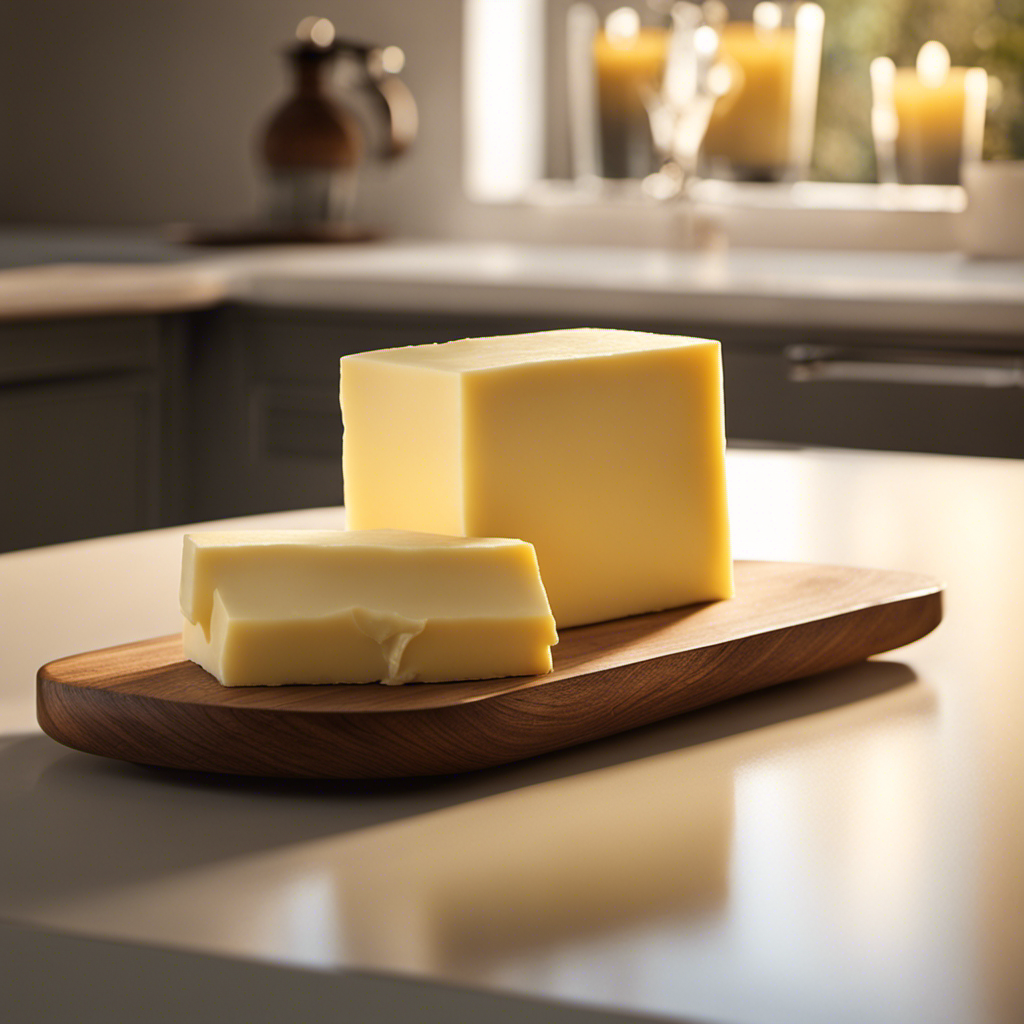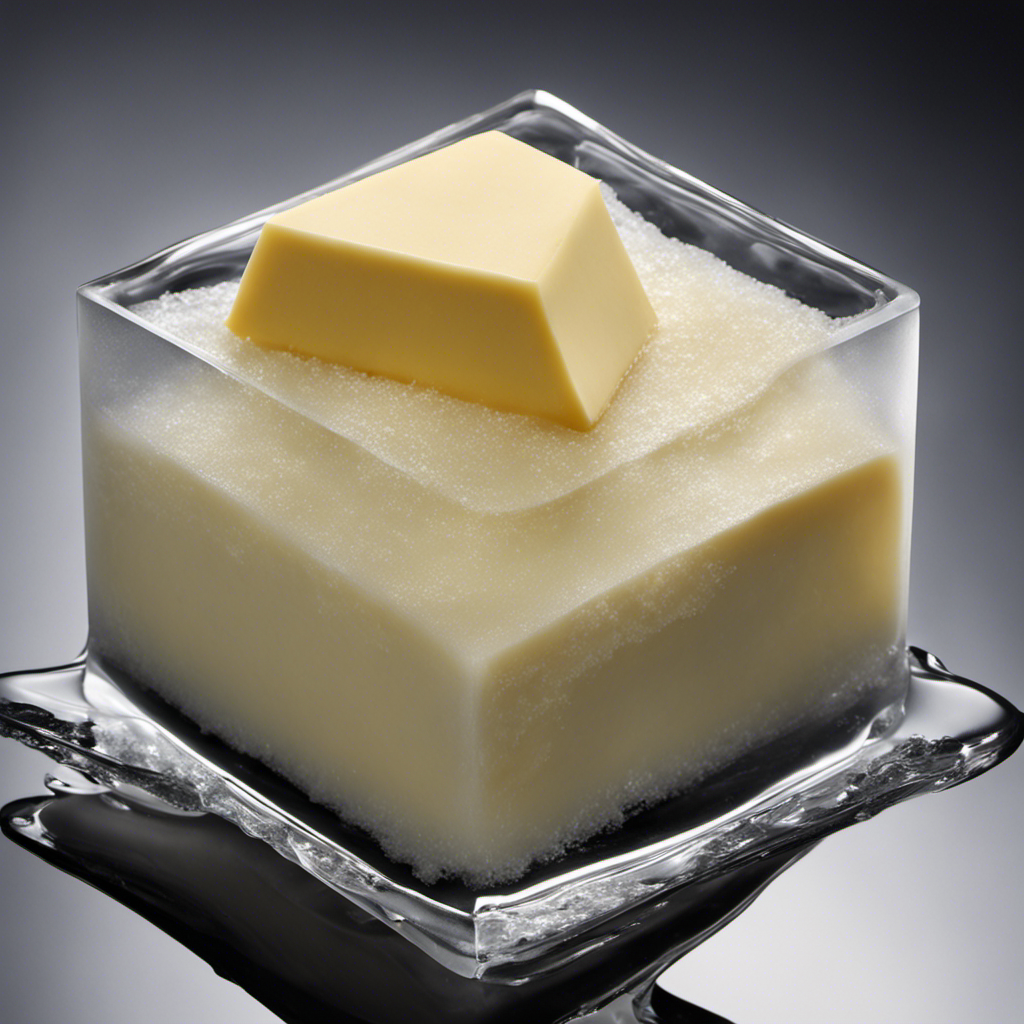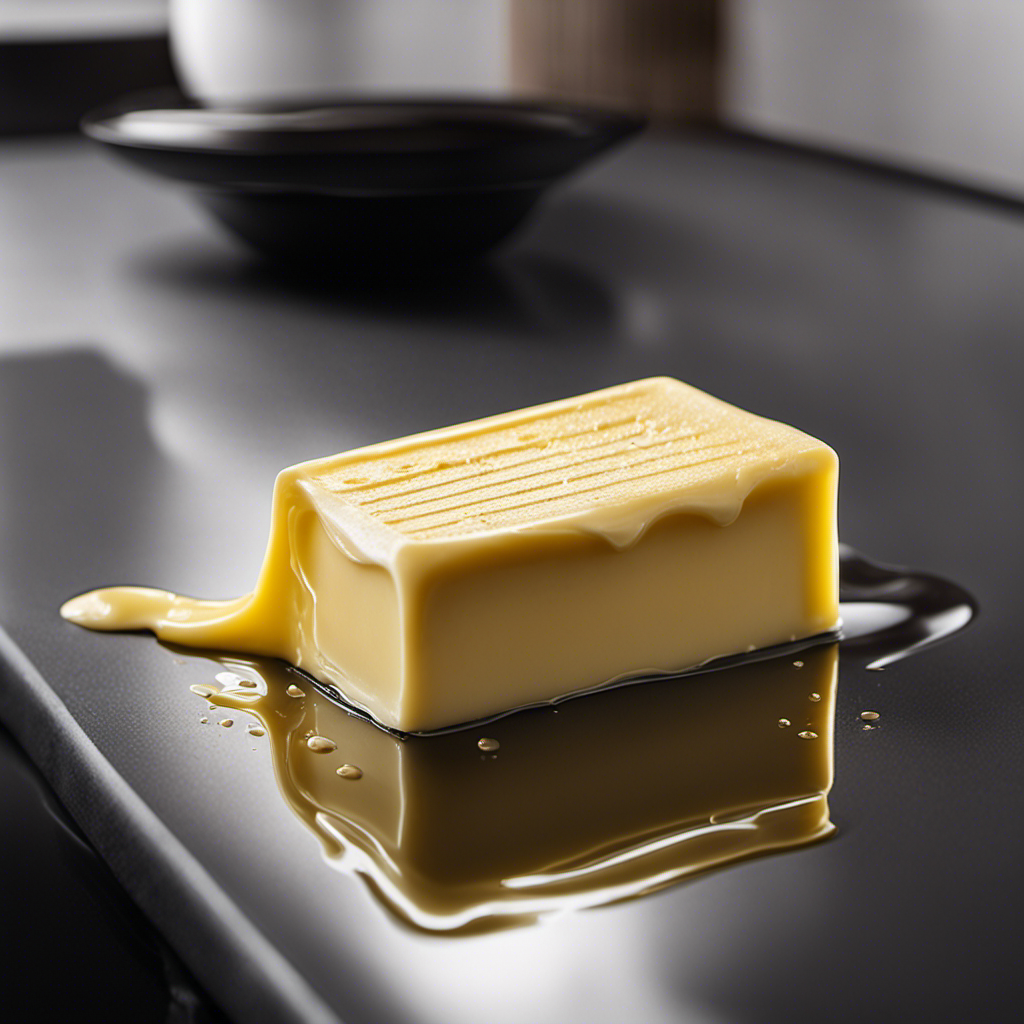Patience is often considered a virtue, but when it comes to waiting for butter to soften, who has the time?
I’ll let you in on a little secret: there’s a science behind getting that perfectly spreadable, room temperature butter in a flash.
In this article, I’ll guide you through the factors that affect the time it takes for butter to reach room temperature and share some quick methods to speed up the process.
No more waiting around – let’s get that butter soft and ready to go!
Key Takeaways
- Room temperature butter is crucial for achieving the desired texture in baked goods.
- Ambient temperature plays a significant role in the speed of butter softening.
- Larger butter blocks take longer to soften, while smaller ones soften faster.
- Quick methods like the microwave method, grating method, pounding method, or leaving it on the counter can be used to speed up the softening process.
The Importance of Room Temperature Butter
Room temperature butter is essential for achieving the perfect texture in baked goods. It plays a crucial role in the overall success of your recipes. When butter is at room temperature, it blends more easily with other ingredients, resulting in a smoother and more consistent batter. This is especially important when making cakes, cookies, and pastries.
Softening the butter before use also allows it to incorporate air more effectively during the creaming process, resulting in a lighter and fluffier final product. In addition, room temperature butter ensures even distribution of fats throughout the dough, leading to a more even rise and better overall structure.
Factors Affecting the Time It Takes for Butter to Reach Room Temperature
When it comes to the time it takes for butter to reach room temperature, two key factors come into play: the ambient temperature of the room and the size of the butter block.
The ambient temperature can greatly impact the speed at which the butter softens, with warmer temperatures causing it to soften more quickly.
Additionally, the size of the butter block can also affect the time it takes for it to reach room temperature, with smaller blocks softening faster than larger ones.
Ambient Temperature’s Impact
To speed up the process, you can place the butter in a warmer area to help it reach the right temperature faster. The ambient temperature plays a significant role in how long it takes for butter to come to room temperature. Here’s how it impacts the process:
-
Higher ambient temperatures: When the room is warmer, the butter will naturally soften more quickly. The heat from the surroundings helps to raise the temperature of the butter, making it easier to spread or incorporate into recipes.
-
Lower ambient temperatures: In colder rooms, butter takes longer to reach room temperature. The colder environment slows down the softening process, requiring more time for the butter to become malleable and spreadable.
-
Consistent ambient temperature: Maintaining a stable room temperature helps ensure that the butter softens evenly. Sudden changes in ambient temperature can lead to uneven softening, resulting in a mixture of soft and still firm butter.
Butter Block Size
The size of the butter block affects how quickly it softens. When the butter is in a large block, it takes longer for the heat to penetrate and melt the entire block. This means that it will take longer for the butter to come to room temperature.
On the other hand, when the butter is in smaller molds or portions, it will melt and soften more quickly. This is because the smaller surface area allows for faster heat transfer. Additionally, smaller butter molds can be more convenient as they can be easily portioned and used as needed.
Quick Methods to Soften Butter
If you’re in a hurry, you can use the microwave to quickly soften your butter. Just be careful not to melt it completely, as the melting point of butter is around 90-95°F (32-35°C).
Here are a few quick methods to soften butter:
-
Microwave method: Cut the butter into small pieces and place it in a microwave-safe bowl. Heat it in short bursts of 5-10 seconds, checking and stirring in between, until it reaches the desired softness.
-
Grating method: Take a frozen stick of butter and grate it using a cheese grater. The smaller pieces will soften faster.
-
Pounding method: Place the butter between two sheets of plastic wrap and use a rolling pin or meat tenderizer to pound it gently. This will help break down the cold butter and make it easier to spread.
How Long Does It Take for Butter to Soften on the Counter
On the counter, it typically takes butter about 30 minutes to reach a spreadable consistency. However, if you’re short on time and looking for quick ways to soften butter, there are alternative methods you can try.
One option is to grate the cold butter using a cheese grater. This increases the surface area of the butter, allowing it to soften more quickly.
Another method is to cut the butter into small cubes and place them in a microwave-safe bowl. Microwave the butter for 10-second intervals, checking and stirring in between, until it reaches the desired softness. Just be careful not to melt the butter completely.
These alternative methods can help you soften butter faster when you need it in a pinch.
Using the Microwave to Speed Up Softening Process
Microwaving the butter in short intervals is a quick way to soften it when you’re in a hurry. However, it’s important to follow proper microwave safety precautions to avoid any mishaps. Here are a few tips to ensure safe softening of butter in the microwave:
-
Cut the butter into smaller pieces: This helps to ensure even melting and prevents the butter from overheating in certain spots.
-
Use a microwave-safe container: Make sure to use a container that is specifically labeled as microwave-safe to avoid any potential melting or release of harmful chemicals.
-
Use low power settings: Start with a low power setting, such as 30%, and microwave the butter in short bursts of 10-15 seconds, checking and stirring in between each interval.
While microwaving is a convenient method, there are alternative ways to soften butter. Leaving it at room temperature for about 30 minutes or grating it using a cheese grater are also effective options. Remember to always prioritize safety and choose the method that works best for you.
Strategies for Softening Butter in a Hurry
When it comes to softening butter in a hurry, there are a few strategies to consider.
First, you can use the microwave or the stovetop method. The microwave method involves cutting the butter into small pieces and microwaving it on low power for short intervals. The stovetop method involves using a double boiler to gently heat the butter.
Additionally, if you’re looking for alternatives to butter, you can try using margarine or coconut oil. Both can be softened quickly.
Finally, using the right cutting techniques can also help speed up the softening process. Slicing the butter into thin pieces or grating it can be effective.
Microwave Vs. Stovetop
The best way to quickly soften butter is by using the microwave, but some people prefer the stovetop method. When it comes to microwave safety, it’s important to remember a few key points:
- Always use a microwave-safe container to heat the butter.
- Cut the butter into smaller pieces to ensure even heating and prevent any hot spots.
- Start by microwaving the butter for 5-10 seconds at a time, checking and flipping it between each interval until it reaches the desired softness.
On the other hand, if you prefer the stovetop method for temperature control, follow these steps:
- Place the butter in a heatproof bowl and set it on top of a pot filled with simmering water.
- Stir the butter occasionally to ensure even heating and prevent it from melting too quickly.
- Keep a close eye on the butter to avoid overheating, as this can lead to a greasy texture.
Both methods have their advantages, so choose the one that suits your preference and convenience.
Butter Alternatives
When it comes to butter alternatives, there are quite a few options available. Whether you’re avoiding dairy or simply looking for a healthier alternative, these substitutes can come in handy. Here are some popular butter alternatives and their quick softening methods:
| Butter Alternative | Quick Softening Method |
|---|---|
| Margarine | Leave it at room temperature for a few minutes or microwave for a few seconds. |
| Coconut oil | Place the jar in a bowl of warm water to soften it quickly. |
| Avocado | Mash it with a fork to achieve a soft and spreadable consistency. |
| Nut butter | Microwave it for a few seconds or let it sit at room temperature until soft. |
Cutting Techniques
To achieve precise and even cuts, try using a sharp knife and applying gentle pressure. Proper cutting techniques can make a significant difference in the outcome of your dishes.
Here are some tips to improve your cutting skills:
-
Hold the knife with a firm grip, ensuring that your fingers are curled under and your thumb is resting on the blade for stability.
-
Use a rocking motion when chopping herbs or vegetables to create uniform pieces.
-
When slicing meats or bread, make sure to use a sawing motion rather than pressing down too hard, as this can result in uneven cuts.
Additionally, the temperature of the butter can also affect your cutting technique. If the butter is too cold, it can be difficult to cut smoothly. Allowing the butter to come to room temperature before cutting can make the process much easier and yield better results.
Best Practices for Storing Butter at Room Temperature
If you want to store butter at room temperature, make sure to follow these best practices.
When it comes to storing butter at room temperature, using the right container is crucial. The best butter storage containers are those that are airtight and opaque, as they help to protect the butter from light and air, which can cause it to spoil. Glass jars or ceramic crocks with tight-fitting lids are popular choices.
However, it’s important to note that room temperature butter does come with its pros and cons. On the one hand, room temperature butter is soft and spreadable, making it convenient for spreading on bread or toast. On the other hand, it can spoil faster than refrigerated butter, so it’s important to use it within a week and to store it in a cool, dry place away from direct sunlight.
Frequently Asked Questions
Can I Use a Different Type of Fat Instead of Butter in Recipes That Call for Room Temperature Butter?
Yes, you can use alternative fats like margarine or shortening in recipes that call for room temperature butter. However, keep in mind that butter adds flavor, moisture, and richness to baked goods that other fats may not replicate.
Is It Safe to Leave Butter Out at Room Temperature for an Extended Period of Time?
It’s safe to leave butter out at room temperature for a few hours, but any longer and it can spoil. To keep it fresh, store butter in the fridge or use alternatives like margarine or coconut oil.
Can I Use a Butter Dish or Container to Soften Butter More Quickly?
Using a butter dish or container won’t soften butter more quickly. To speed up the process, I recommend using a microwave on low power or placing the butter in a sealed bag and submerging it in warm water.
What Is the Ideal Room Temperature for Softening Butter?
The ideal room temperature for softening butter is around 70 degrees Fahrenheit. At this temperature, the butter will gradually soften without melting too quickly. It usually takes about 30 minutes to an hour for butter to come to room temperature.
Can I Use a Food Processor or Blender to Quickly Soften Butter?
Using a food processor or blender to soften butter quickly can be tempting, but it’s not recommended. These appliances can create excessive heat, causing the butter to melt instead of just softening.
Conclusion
In conclusion, having room temperature butter is crucial for effortless spreading and incorporating into recipes. The time it takes for butter to soften can be influenced by various factors, such as the temperature of the room and the size of the butter block.
However, with quick methods like slicing the butter or using a microwave, you can speed up the softening process. Remember, storing butter at room temperature in a proper container ensures its freshness and easy usability.
So, don’t delay in defrosting your dairy delight for delectable dishes!









